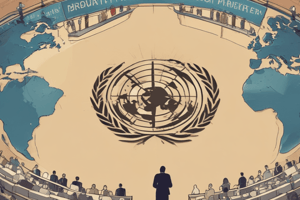Podcast
Questions and Answers
¿Cuál es el propósito principal de los tratados internacionales?
¿Cuál es el propósito principal de los tratados internacionales?
- Imponer obligaciones unilaterales a los países más débiles.
- Facilitar relaciones armoniosas entre estados soberanos. (correct)
- Eliminar por completo las barreras comerciales entre países vecinos.
- Establecer una jerarquía entre los países involucrados.
¿Qué tipo de tratado está dirigido a proteger las libertades básicas de los seres humanos en todo el mundo?
¿Qué tipo de tratado está dirigido a proteger las libertades básicas de los seres humanos en todo el mundo?
- Tratado para la eliminación de aranceles.
- Tratado de Derechos Humanos. (correct)
- Tratado para el estímulo de la competencia global.
- Tratado de Comercio y Economía.
¿Qué documento establece los derechos humanos fundamentales a nivel mundial?
¿Qué documento establece los derechos humanos fundamentales a nivel mundial?
- Convención Internacional de Derechos Humanos.
- Carta Magna Internacional de Libertades Humanas.
- Declaración Universal de Derechos del Hombre. (correct)
- Tratado Global de Protección Humana.
¿Qué aspecto NO es regulado por los tratados internacionales de comercio y economía?
¿Qué aspecto NO es regulado por los tratados internacionales de comercio y economía?
¿Cuál es uno de los objetivos de los tratados internacionales en relación con los derechos humanos?
¿Cuál es uno de los objetivos de los tratados internacionales en relación con los derechos humanos?
¿Cuál es un área principal abordada por tratados internacionales relacionados con protección ambiental?
¿Cuál es un área principal abordada por tratados internacionales relacionados con protección ambiental?
¿Qué tipo de tratado se enfoca en la resolución de conflictos, la asistencia humanitaria y las limitaciones a la fuerza militar?
¿Qué tipo de tratado se enfoca en la resolución de conflictos, la asistencia humanitaria y las limitaciones a la fuerza militar?
¿Qué se requiere para que un tratado internacional sea legalmente vinculante después de ser firmado?
¿Qué se requiere para que un tratado internacional sea legalmente vinculante después de ser firmado?
¿Qué papel juegan las organizaciones internacionales en el cumplimiento de los tratados internacionales?
¿Qué papel juegan las organizaciones internacionales en el cumplimiento de los tratados internacionales?
¿Cuál es uno de los ejemplos mencionados de organizaciones que facilitan la integración regional y los acuerdos de seguridad colectiva?
¿Cuál es uno de los ejemplos mencionados de organizaciones que facilitan la integración regional y los acuerdos de seguridad colectiva?
Flashcards are hidden until you start studying
Study Notes
International Treaties
International treaties are legally binding agreements between two or more countries that establish rights and obligations among them. These documents often reflect shared values and principles among nations, providing the basis for peaceful cooperation and addressing common concerns such as security, trade, human rights, environment, and natural resources. The goal is to promote peace, economic progress, and social justice by facilitating harmonious relations among sovereign states.
Types of International Treaties
There are several categories of international treaties based on their subject matter:
-
Human Rights: Treaties related to human rights aim to protect basic human freedoms worldwide, including civil liberties; political, cultural, and linguistic rights; and legal protection from discrimination. Examples include the Universal Declaration of Human Rights, which sets out fundamental human rights, and the Convention against Torture and Other Cruel, Inhuman or Degrading Treatment or Punishment, aimed at preventing torture and other cruel treatments or punishments throughout the world.
-
Economic and Trade Agreements: These treaties govern various aspects of global commerce, encouraging cross-border investment, removing barriers to trade, reducing tariffs, promoting competition, safeguarding intellectual property, and fostering technology transfer. Prominent examples include NAFTA (North American Free Trade Agreement) and GATT (General Agreement on Tariffs and Trade).
-
Environmental Protection: Environmental treaties seek to address issues like pollution control, wildlife conservation, climate change, and sustainable development. Key treaties here include the Kyoto Protocol, aimed at controlling greenhouse gas emissions, and the Montreal Protocol on Substances That Deplete the Ozone Layer, which aims to phase out ozone depleting substances.
-
Peace and Security: Treaties under this category focus on disarmament and nonproliferation efforts, arms reduction initiatives, conflict resolution mechanisms, humanitarian assistance, and military force limitations. Notable examples include the Nuclear Non-Proliferation Treaty (NNPT), Chemical WeaponsConvention (CWC), Biological and Toxin Weapons Convention (BTWC), and Comprehensive Test Ban Treaty (CTBTO).
-
Refugees and Migrants: These treaties pertain to migration, refugee status determination, displaced persons, and stateless individuals, forming one of the first areas of concern addressed through international law. Major instruments here include the 1951 Refugee Convention and its 1967 Protocol Relating to the Status of Refugees, along with the UN Global Compact on Refugees.
-
Regional Cooperation Organizations: Some treaties facilitate regional integration and collective security arrangements, allowing signatories to cooperate in matters relating to economics, politics, defense, and foreign policy. Examples include NATO (the North Atlantic Treaty Organization), ASEAN (Association of Southeast Asian Nations), SADC (Southern African Development Community), and others.
Signature and Ratification Process
Before entering into force, every treaty must be approved and formally signed by all parties involved. This process usually occurs within the context of a formal ceremony attended by representatives from each country participating in the agreement. Once signed, it becomes legally binding only after being ratified by each state party's legislature. After signing, some treaties may also require further action before they can enter into force, such as depositing instruments of ratification, acceptance, approval, or accession with a relevant international organization or government body.
Compliance with International Treaties
While some countries choose voluntary compliance with treaty provisions without fear of reprisals, many international organizations have developed regimes for monitoring and enforcing treaty commitments. For example, the World Health Organization monitors signatory governments’ implementation of the Framework Convention on Tobacco Control, while the United States uses information gathered during the ABM Treaty IAEA inspections to maintain a safe distance between US missiles and Russia. Additionally, some treaties like the Vienna Conventions on Diplomatic and Consular Relations allow for a diplomat to refer any breach of these conventions directly to his home government.
Impact of International Treaties
The impact of international treaties extends beyond simply codifying international rules and standards. They help create a common understanding and discourse around specific issues, facilitating collaboration and coordination among multiple actors. By setting clear expectations about what constitutes acceptable behavior, they minimize uncertainty and reduce instances where different interpretations might lead to conflicts or misunderstandings. Moreover, treaties serve as a means for transforming normative change—as new ideas gain traction and spread globally, treaties offer institutions and mechanisms that can support their adoption and enforcement.
Studying That Suits You
Use AI to generate personalized quizzes and flashcards to suit your learning preferences.





